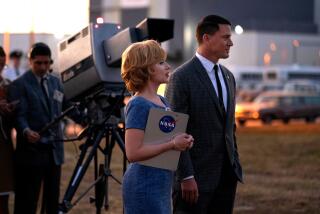Thomas Kelly, 72; Head of NASA’s Lunar Module Team
- Share via
Thomas Kelly, director of the engineering team that designed and built the lunar module that ferried astronauts Neil Armstrong and Edwin E. “Buzz” Aldrin Jr. to and from the lunar surface during their historic 1969 flight to the moon, has died.
He was 72.
Kelly, dubbed “the father of the lunar module” by NASA, died Saturday of pulmonary fibrosis at his home in Cutchogue, N.Y.
On July 20, 1969, the lunar module carrying Armstrong and Aldrin touched down on the powdery surface of the moon. “Houston, Tranquillity Base here,” Armstrong radioed. “The Eagle has landed.”
In the Spacecraft Analysis Room next to Mission Control at the National Aeronautics and Space Administration Center in Houston, Kelly had been troubleshooting problems throughout the flight.
But his thrill at the lunar module’s successful landing quickly turned to concern as control monitors signaled a significant problem: Ice had formed in a fuel line and become stuck; residual heat from the engine was moving up toward the frozen fuel.
If the fuel got hot enough, it could detonate.
“We were on the verge of taking action when the problem corrected itself,” Kelly said. “So after that I was able to relax and say, ‘Wow, we did it!’”
For Kelly, “we” meant the 3,000 engineers and 4,000 technicians and mechanics at Grumman Aerospace Corp. in Bethpage, N.Y., who spent seven years designing and building the lunar module under Kelly’s leadership.
“Tom Kelly was a major force in our nation’s space race,” said Joshua Stoff, curator of the Cradle of Aviation Museum in Garden City, N.Y., home to one of three remaining lunar modules.
“He designed one of the most historic vehicles ever built,” Stoff said Monday. “It’s the only vehicle that ever took human beings from one world to another, and nothing else before or since has ever been like [it].”
Resembling a bizarre insect, the lunar module had four spindly legs and a lumpy body.
It was covered with a thin skin of gold-aluminized Mylar. It weighed 12,000 pounds empty and about 30,000 pounds with fuel. And it measured 29 feet across from footpad to footpad and was about as tall.
“Since it was only working in space it didn’t need to have any aerodynamic qualities whatsoever, so its shape and form are perfectly functional,” Stoff said.
“That’s why it’s a very oddly shaped vehicle with things sticking out all over it: legs and antennas, fuel tanks--all sorts of things.”
Stoff said Kelly was instrumental in conceiving the idea that only part of the spacecraft that blasted off from Earth would make the final step of the journey back from the moon’s surface.
The lunar module consisted of two stages: When lifting off from the moon, the bottom half served as the launch pad and the astronauts rode the top half back to the orbiting command module.
Fifteen lunar modules were built, carrying Apollo astronauts from their command module to the moon’s surface six times between 1969 and 1972.
Stoff, who became friends with Kelly after interviewing him for Stoff’s 1985 book on the lunar module program, “Chariots for Apollo,” described Kelly as “a small man and very much an engineer in the way he talked--straightforward and very quiet.”
Born in Brooklyn and raised in Merrick on Long Island, Kelly became fascinated with engineering in high school.
He graduated as valedictorian with a four-year Grumman engineering scholarship to study at Cornell University and work summers at Grumman.
After graduating from Cornell in 1951 with a degree in mathematical engineering and an ROTC commission in the Air Force Reserve, Kelly joined Grumman full time.
He worked on advanced missile and aircraft programs until he was called to active duty in 1956.
A year later, the Russians launched Sputnik, the first satellite. “At that moment,” Kelly once said, “I became interested in space.”
After being discharged from the Air Force in 1958, he worked briefly for Lockheed before Grumman lured him back to Long Island.
“They told me that they were going to set up a design group to look for business in space, and they wanted me to help them,” he told the New York Times in 1999.
“At that time, we were only in a ‘what if’ stage, and I was one of only two men working on a lunar project to explore the technical issues of getting to the moon.”
The space race heated up even more in 1961, when the Soviet Union put the first man into orbit and President Kennedy declared that the nation should commit itself to “landing a man on the moon and returning him safely to Earth” by the end of the decade.
“He picked the most ambitious project possible,” Kelly said. “His commitment changed the ballgame for everyone in the industry, and companies began to jockey for position to compete in building spacecraft.”
In 1962, Grumman won a $2-billion government contract to build the lunar module.
For seven years, the lunar project dominated Kelly’s life. Twelve-hour days were typical.
“Nobody at Grumman who worked on the [lunar module] will ever forget it,” Kelly said in 1998. “From the sweeper to the chief engineer, we all knew we were part of a majestic venture. We were making history.”
After he retired, Kelly wrote a book about his Apollo experiences, “Moon Lander: How We Developed the Apollo Lunar Module,” published last year by Smithsonian Institution Press.
Kelly is survived by his wife Joan; six children and 10 grandchildren.
More to Read
Sign up for Essential California
The most important California stories and recommendations in your inbox every morning.
You may occasionally receive promotional content from the Los Angeles Times.













